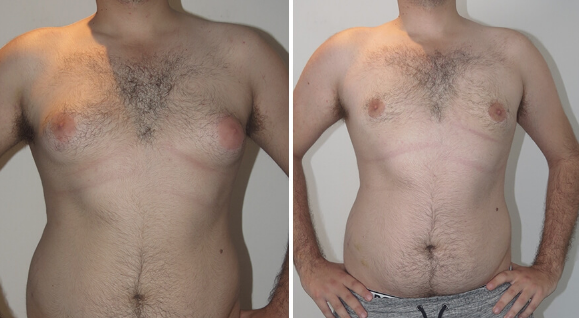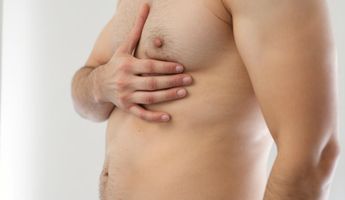Male Breast Reduction in Ireland
Find the best clinics for Male Breast Reduction in Ireland
No clinics available
India offers the best prices Worldwide
Price: $ 692

WHY US?
At Medijump, we're making medical easy. You can search, compare, discuss, and book your medical all in one place. We open the door to the best medical providers worldwide, saving you time and energy along the way, and it's all for FREE, no hidden fees, and no price markups guaranteed. So what are you waiting for?

Free

Best Price

Widest Selection

Risk-Free
What you need to know about Male Breast Reduction in Ireland

Male breast reduction, also known as gynecomastia correction, is a surgical procedure to treat overdeveloped male breasts or gynecomastia – a condition in which male breasts are enlarged due to imbalance of the hormones estrogen and testosterone. The procedure is usually performed on men whose physical health is affected by the condition or men who feel uncomfortable or self-conscious about their chest. The ideal candidates for this procedure are healthy men with skin that is elastic to adjust to breast reduction.
What Does the Procedure Involve?
Male breast reduction is carried out under general anesthetic or local anesthetic with sedation. The procedure starts by making an incision around the nipple to remove fat as well as glandular tissue from the breast, as well as some excess skin. In some cases, your surgeon may also perform liposuction in conjunction with the procedure to remove fat. The final step of the procedure is closing the incisions with stitches.
How Long Should I Stay in Ireland for a Male Breast Reduction Procedure?
The procedure is usually performed on an outpatient basis, meaning you can leave the hospital on the same day of the surgery. However, you should not leave Ireland immediately to allow your body to recover and attend follow-up hospital checkups. Plan to stay in the country for at least 5 to 10 more days.
What's the Recovery Time for Male Breast Reduction Procedures in Ireland?
The total recovery period until you can go back to your full routine can take around a month. However, some people whose jobs are not physically demanding are able to return to work as well as some of their activities in 1-2 weeks.
What sort of Aftercare is Required for Male Breast Reduction Procedures in Ireland?
Your surgeon will give you detailed instructions on how to care for your surgical wounds as well as diet and exercise to avoid complications. You may need to wear a pressure garment during your recovery period to reduce bruising and swelling. To maintain the result of your surgery, make sure to maintain a healthy weight by making some healthy lifestyle changes.
What's the Success Rate of Male Breast Reduction Procedures in Ireland?
The procedure is generally safe and highly successful. However, just like other types of surgery, it carries some degree of side effects and risks that you need to be aware of. The side effects and risks include skin injury, noticeable scar, permanent pigment changes in the breast, slightly mismatched nipples or breasts, loss of breast sensation, numbness, and excessive bleeding.
Are there Alternatives to Male Breast Reduction Procedures in Ireland?
Male breast reduction is currently the most effective treatment to reduce enlarged male breasts. If you do not want to undergo surgery, you need to consult with your doctor about what your best options are. In some cases, your doctor may recommend liposuction to remove excess fat from your breasts, but leaving breast gland tissue intact.
What Should You Expect Before and After the Procedure
Before male breast reduction, your enlarged breast may affect you physically or you may feel very self-conscious. After the procedure, your self-esteem and self-confidence may increase significantly and any physical problems you experience before the procedure should be gone.
Whilst the information presented here has been accurately sourced and verified by a medical professional for its accuracy, it is still advised to consult with your doctor before pursuing a medical treatment at one of the listed medical providers
No Time?
Tell us what you're looking for and we'll reachout to the top clinics all at once
Enquire Now

Popular Procedures in Ireland
Price on Request

Prices Start From $2

Prices Start From $556

Prices Start From $2,473

Recommended Medical Centers in Ireland for procedures similar to Male Breast Reduction

- Interpreter services
- Translation service
- Religious facilities
- Medical records transfer
- Medical travel insurance
- Health insurance coordination
- TV in the room
- Safe in the room
- Phone in the room
- Private rooms for patients available

- Interpreter services
- Translation service
- Religious facilities
- Medical records transfer
- Medical travel insurance
- Health insurance coordination
- TV in the room
- Safe in the room
- Phone in the room
- Private rooms for patients available

- Interpreter services
- Translation service
- Religious facilities
- Medical records transfer
- Medical travel insurance
- Health insurance coordination
- TV in the room
- Safe in the room
- Phone in the room
- Private rooms for patients available

- Interpreter services
- Translation service
- Religious facilities
- Medical records transfer
- Medical travel insurance
- Health insurance coordination
- TV in the room
- Safe in the room
- Phone in the room
- Private rooms for patients available

- Interpreter services
- Translation service
- Religious facilities
- Medical records transfer
- Medical travel insurance
- Health insurance coordination
- TV in the room
- Safe in the room
- Phone in the room
- Private rooms for patients available

- Interpreter services
- Translation service
- Religious facilities
- Medical records transfer
- Medical travel insurance
- Health insurance coordination
- TV in the room
- Safe in the room
- Phone in the room
- Private rooms for patients available

- Interpreter services
- Translation service
- Religious facilities
- Medical records transfer
- Medical travel insurance
- Health insurance coordination
- TV in the room
- Safe in the room
- Phone in the room
- Private rooms for patients available

- Interpreter services
- Translation service
- Religious facilities
- Medical records transfer
- Medical travel insurance
- Health insurance coordination
- TV in the room
- Safe in the room
- Phone in the room
- Private rooms for patients available
